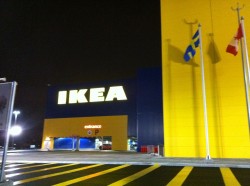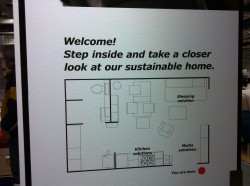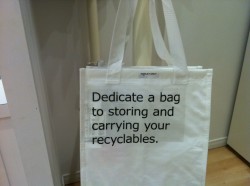 But anyway. We stopped at Ikea on the way back. The new Ikea. The biggest Ikea in Canada. The same Ikea that was making the news for a week in the grand lead-up to the grand opening. The same grand opening that had cops and firefighters and paramedics assigned to it, along with the mayor and a special traffic plan and overnight lineups.
But anyway. We stopped at Ikea on the way back. The new Ikea. The biggest Ikea in Canada. The same Ikea that was making the news for a week in the grand lead-up to the grand opening. The same grand opening that had cops and firefighters and paramedics assigned to it, along with the mayor and a special traffic plan and overnight lineups.
I have to say I was a little disturbed by all the mainstream news coverage this store’s opening received. As Laurie Kingston tweeted, “It’s just a store, people!”
I wouldn’t be surprised if media analysis reveals that Ikea’s opening got more coverage than Police Chief Vern White’s warning to local sex trade workers that there might be a serial killer at work on the streets of Ottawa. (He didn’t say that exactly. He said there was a pattern of violence developing, and, when asked, he refused to rule out the possibility of a serial killer.) The media covered it, of course, but not with the same tenacity that they covered the Ikea opening.
So anyway, GC and I went to Ikea. We were driving right by it on our way back from visiting Chandler, and I guess we got swept up in the hype.
It doesn’t seem all that much bigger than the old Ikea. Less cramped, definitely. More white space. Still the same old maze, still the same old stuff.
 One thing that caught my eye and made me laugh was the “Sustainability Home.”
One thing that caught my eye and made me laugh was the “Sustainability Home.”
This is where Ikea demonstrates how green it is, and encourages you to be green too. A hundred square feet dedicated to sustainability. Apparently Ikea’s idea of a sustainable home is one with signs throughout it saying things like “Put a lid on your pot while boiling water,” and “Turn down your thermostat at night,” and “Take a shorter shower.” All this right in the middle of a half-million square foot shrine to the landfill. I think if Ikea wants to be taken seriously on the subject of the environment, it needs to stop selling disposable crap.
 That being said, I admit to having more than my share of Billy bookcases. And I did buy six wine glasses and three glass jars while I was there Saturday night.
That being said, I admit to having more than my share of Billy bookcases. And I did buy six wine glasses and three glass jars while I was there Saturday night.
Speaking of sustainable homes, though, I got to go on a Green Housing Bus Tour a couple of weeks ago, as part of a workshop at work about the greening of affordable housing. Apparently the non-profit housing sector is leading the way when it comes to energy-efficient housing. I think it’s because the non-profit sector is always looking for ways to save money while doing the right thing, and going green does both.
Here’s where we went:
- Beaver Barracks, which is CCOC’s geo-thermally heated/cooled downtown housing development. It’s got lots of green features.
- The roof of a low-income highrise on Caldwell, to see the solar panels and the water-heating system.
- 1365 Bank, where Ottawa Community Housing saved a whack of water and money by replacing all the toilets.
- An 8,000-square-foot solar wall on Clementine.
- A microFIT home, which is solar panels on top of a house. The solar energy harnessed there is not used to power that house, but is instead sold back into the grid, thereby generating income for the home-owner, which in this case is Ottawa Community Housing. OCH is Ottawa’s largest social housing provider. They installed MicroFIT systems on 30 of their houses, which will soon be generating a quarter of a million dollars revenue per year for them. Brilliant!

















“All this right in the middle of a half-million square foot shrine to the landfill.”
Nice.
While I’m familiar with the association of IKEA with cheap stuff, most of what I get is stuff I find on the curb, so I only end up with the stuff that doesn’t break immediately after purchase. (or at least I get useful raw materials for new projects)
It’s kinda like how when people say “they don’t make things like they used to”, they’re generally thinking about the stuff that was made long ago that hasn’t broken (as opposed to the stuff made long ago that has long since fallen apart and been replaced).
– RG>
I have to agree with Real grouchy. Certainly Ikea has a lot of stuff that is less than sturdy but have you checked out the furniture anywhere else. I have a couch my parents bought in the early sixties. It has been reupholstered but the frame and springs etc are still sound and useful. The thing is it was an extremely expensive couch when they bought it. One of the first times they could afford really well made things. If you go to Leons, Sears, The Brick, etc and buy the cheaper furniture none of it lasts any better than Ikea. By the way I also have a billy bookcase I bought in the early 70s and it is still holding books just like it should.
I have a serious love/hate relationship with Ikea.
I love their prices, because it means I can actually afford it. I’ve gotten some good things (a solid pine computer desk bought 15 years ago that my Mom is still using)and I’ve bought some crap (the $20 coffee table that scratches when you do more anything more than breathe on it).
But what I really hate is shopping there. What little manners and common sense people still have seems to go right out the window – it’s worse than walmart – I don’t understand it!
A regular couch — the one I’m using now is older than I am — can be repaired. If it breaks (more), and I have the money, there are craftspeople out there who can reupholster it, or replace a leg. I bought a $20 2-in-1 lamp at Ikea that worked great, until the product specific bulbs burned out two years later, and I couldn’t find replacements at the same Ikea I bought it at.
That said, the ‘landfill filling’ potential of Ikea, and other modular and affordable furniture is a bit of a cliche.
I have two bookcases, three rugs, some shelves, an end table and a room-sized computer desk from Ikea that have all survived beyond their original cost (ten years for a total of less than $300). If they haven’t broken by now I can see them all lasting another ten years. So there is a level of sustainability in the potential longevity of affordable furniture.
…basically, don’t abuse your shit and the landfills are saved for diapers.
Oh I’m really interested in seeing that solar wall on Clementine! Good stuff! I heard that the Ottawa Sustainability Fund is helping out with some grants (http://www.osfund.ca/)!